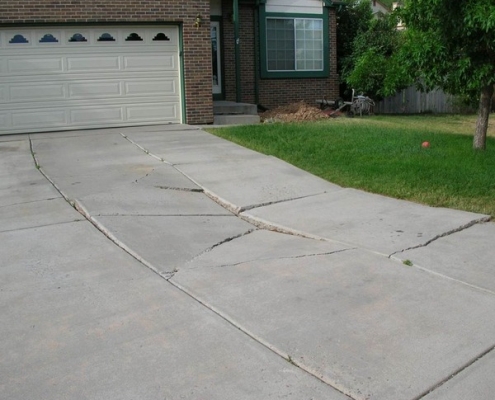Remove and Replace the Concrete
Sometimes, this option is the only one available to the building owner due to excessive damage to the existing concrete slab. If a slab is to be replaced, the old concrete will need to be jackhammered out and hauled away for disposal. A new driveway or sidewalk can then be framed, steel rebar is installed and concrete is then poured. This is generally the most expensive option, with a typical new driveway costing in excess of $10,000. Once the size and any design patterns are considered, the costs can escalate even further. This process will also take several days or longer once things like demolition, pouring time, and concrete curing are factored into consideration. The attributes to consider for this option are:
– Cost
– Disturbance to the surrounding area
– Amount of time the slab will be in the “demolition and construction” phase
– High energy consumption (Manufacturing of new cement is heat intensive)
– Landfill or recycling costs for the concrete that was removed
Concrete Lifting
Another option is to have the sunken concrete lifted back into place by injecting material below the concrete surface. In general, holes are strategically located and drilled into the sunken concrete slab. Once the holes are drilled, pumping equipment is fastened to the holes and material is pumped into them.
Polyurethane Foam Injection
In the case of polyurethane foam injection, the polyurethane starts out as two separate components (A and B) that are stored in the service vehicle. The A and B components are pumped through a heated hose to an injection gun. The injection gun is placed on a special tip that is inserted into a 5/8th inch hole drilled into the slab. The A and B components that were pumped through the hose are mixed together in the gun just before they are injected under pressure below the concrete slab. Once injected, they quickly begin to form a new material; the polyurethane foam. The polyurethane foam expands quickly. It is this expansion force that lifts the concrete into place in seconds. Very quickly, the polyurethane foam begins to cure after it has finished expanding to form a very strong but lightweight support for the concrete above. Because of its light weight, the polyurethane foam will add minimal load to the subgrade below. The process is repeated until the entire slab is lifted back into position and is level. Once the slab lifting is complete, the small 5/8th inch holes are filled in and sealed using a concrete filler mix to patch the hole. Because the holes are small, and the patch uses a concrete filler, over time, the patches should blend into the surrounding slab due to weathering and exposure.





